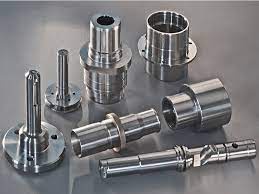Machined casting is a manufacturing process that combines the advantages of both casting and machining to produce complex and precision components. It involves pouring molten metal into a mold and then using machining techniques to refine and shape the casted part to its final specifications. This process has gained significant popularity in the manufacturing industry due to its ability to produce intricate designs with high dimensional accuracy and surface finish. In this article, we will explore the various aspects of machined casting and discuss its contributions to the manufacturing industry. Overview of Machined Casting: machined casting is a multi-step process that begins with the creation of a mold. The mold is typically made of sand, plaster, or metal and is designed to have the negative shape of the desired part. Molten metal is then poured into the mold, allowing it to solidify and take the shape of the mold cavity. After the casting solidifies, it undergoes various machining operations such as milling, drilling, turning, and grinding to achieve the desired dimensions, surface finish, and tolerances. Advantages of Machined Casting: 2.1. Design Flexibility: Machined casting offers great design flexibility, allowing the production of complex shapes and features that are difficult or impossible to achieve with other manufacturing processes. The mold can be customized to accommodate intricate details, undercuts, and thin-walled sections. 2.2. Cost-Effectiveness: Machined casting can be a cost-effective manufacturing method, especially for low to medium volume production. The initial investment for creating the mold may be high, but once it is made, subsequent parts can be produced relatively quickly and inexpensively. 2.3. Material Versatility: Machined casting is compatible with a wide range of metals and alloys, including aluminum, iron, steel, brass, and titanium. This versatility allows manufacturers to choose the most suitable material for their specific application, balancing properties such as strength, corrosion resistance, and heat resistance. 2.4. Improved Mechanical Properties: The casting process allows for directional solidification, resulting in improved mechanical properties of the final component. This includes enhanced tensile strength, fatigue resistance, and overall structural integrity. 2.5. Reduced Machining Time: Since machined casting produces parts that are close to their final shape, the amount of material that needs to be removed during machining is significantly reduced. This leads to shorter machining times and increased productivity. Applications of Machined Casting: Machined casting finds applications in various industries, including automotive, aerospace, medical, and energy sectors. Some common applications include engine blocks, cylinder heads, turbine blades, pump housings, and intricate surgical instruments. The ability to produce complex geometries and high-quality surface finishes makes machined casting ideal for parts that require both structural integrity and aesthetic appeal. Challenges and Considerations: While machined casting offers numerous advantages, there are also challenges and considerations to be aware of. These include: 4.1. Mold Design and Fabrication: The design and fabrication of the mold are critical to achieving high-quality castings. Proper consideration must be given to factors such as part shrinkage, gating and riser design, and cooling rates to avoid defects like porosity, shrinkage cavities, or thermal stresses. 4.2. Machining Complexity: Machining casted parts can be more complex compared to machining from solid blocks. The presence of internal cavities and intricate features may require specialized machining techniques and tools. 4.3. Post-Casting Inspection: Quality control and inspection are crucial in machined casting. The casting needs to be inspected for dimensional accuracy, surface defects, and material integrity to ensure that it meets the desired specifications and performance requirements. Future Developments and Conclusion: The field of machined casting continues to evolve with advancements in materials, mold design, machining technologies, and process automation. Computer-aided design and simulation tools are being used to optimize mold designs and predict casting defects, leading to improved casting quality and reduced lead times. Additionally, additive manufacturing techniques are being integrated with machined casting, allowing the creation of hybrid components with enhanced functionality and performance. In conclusion, machined casting is a valuable manufacturing process that combines the benefits of casting and machining to produce intricate and precise components. Its design flexibility, cost-effectiveness, material versatility, improved mechanical properties, and reduced machining time make it a preferred choice in various industries. However, careful consideration must be given to mold design, machining complexity, and post-casting inspection to ensure high-quality castings. As technology advances, machined casting is expected to further expand its capabilities, enabling the production of even more complex and functional parts in the future.
What is machined casting and how does it contribute to the manufacturing industry

In case you have found a mistake in the text, please send a message to the author by selecting the mistake and pressing Ctrl-Enter.

No comments yet